
Edward George Earle Lytton Bulwer-Lytton, 1st Baron Lytton, PC was an English writer and politician. He served as a Whig member of Parliament from 1831 to 1841 and a Conservative from 1851 to 1866. He was Secretary of State for the Colonies from June 1858 to June 1859, choosing Richard Clement Moody as founder of British Columbia. He declined the Crown of Greece in 1862 after King Otto abdicated. He was created Baron Lytton of Knebworth in 1866.

Sir John Everett Millais, 1st Baronet, was an English painter and illustrator who was one of the founders of the Pre-Raphaelite Brotherhood. He was a child prodigy who, aged eleven, became the youngest student to enter the Royal Academy Schools. The Pre-Raphaelite Brotherhood was founded at his family home in London, at 83 Gower Street. Millais became the most famous exponent of the style, his painting Christ in the House of His Parents (1849–50) generating considerable controversy, and he produced a picture that could serve as the embodiment of the historical and naturalist focus of the group, Ophelia, in 1851–52.

The Pre-Raphaelite Brotherhood was a group of English painters, poets, and art critics, founded in 1848 by William Holman Hunt, John Everett Millais, Dante Gabriel Rossetti, William Michael Rossetti, James Collinson, Frederic George Stephens and Thomas Woolner who formed a seven-member "Brotherhood" modelled in part on the Nazarene movement. The Brotherhood was only ever a loose association and their principles were shared by other artists of the time, including Ford Madox Brown, Arthur Hughes and Marie Spartali Stillman. Later followers of the principles of the Brotherhood included Edward Burne-Jones, William Morris and John William Waterhouse.

William Holman Hunt was an English painter and one of the founders of the Pre-Raphaelite Brotherhood. His paintings were notable for their great attention to detail, vivid colour, and elaborate symbolism. These features were influenced by the writings of John Ruskin and Thomas Carlyle, according to whom the world itself should be read as a system of visual signs. For Hunt it was the duty of the artist to reveal the correspondence between sign and fact. Of all the members of the Pre-Raphaelite Brotherhood, Hunt remained most true to their ideals throughout his career. He was always keen to maximise the popular appeal and public visibility of his works.

John William Waterhouse was an English painter known for working first in the Academic style and for then embracing the Pre-Raphaelite Brotherhood's style and subject matter. His artworks were known for their depictions of women from both ancient Greek mythology and Arthurian legend.
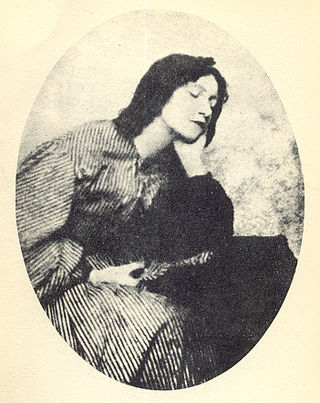
Elizabeth Eleanor Siddall, better known as Elizabeth Siddal, was an English artist, poet, and artists' model. Significant collections of her artworks can be found at Wightwick Manor and the Ashmolean. Siddal was painted and drawn extensively by artists of the Pre-Raphaelite Brotherhood, including Walter Deverell, William Holman Hunt, John Everett Millais, and especially by her husband, Dante Gabriel Rossetti.

Ophelia is an 1851–52 painting by British artist Sir John Everett Millais in the collection of Tate Britain, London. It depicts Ophelia, a character from William Shakespeare's play Hamlet, singing before she drowns in a river.

The Hireling Shepherd (1851) is a painting by the Pre-Raphaelite artist William Holman Hunt. It represents a shepherd neglecting his flock in favour of an attractive country girl to whom he shows a death's-head hawkmoth. The meaning of the image has been much debated.
Events from the year 1849 in art.

The Light of the World (1851–1854) is an allegorical painting by the English Pre-Raphaelite artist William Holman Hunt (1827–1910) representing the figure of Jesus preparing to knock on an overgrown and long-unopened door, illustrating Revelation 3:20: "Behold, I stand at the door and knock; if any man hear My voice, and open the door, I will come in to him, and will sup with him, and he with Me". According to Hunt: "I painted the picture with what I thought, unworthy though I was, to be divine command, and not simply a good subject." The door in the painting has no handle, and can therefore be opened only from the inside, representing "the obstinately shut mind". The painting was considered by many to be the most important and culturally influential rendering of Christ of its time.

John Brett was a British artist associated with the Pre-Raphaelite movement, mainly notable for his highly detailed landscapes.
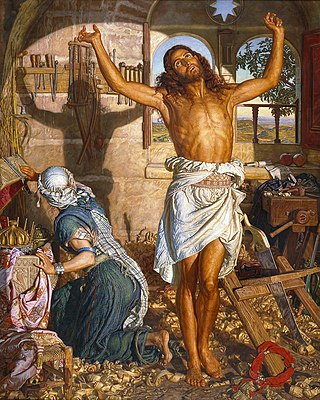
The Shadow of Death is a religious painting by William Holman Hunt, on which he worked from 1870 to 1873, during his second trip to the Holy Land. It depicts Jesus as a young man prior to his ministry, working as a carpenter. He is shown stretching his arms after sawing wood. The shadow of his outstretched arms falls on a wooden spar on which carpentry tools hang, creating a "shadow of death" prefiguring the crucifixion. His mother Mary is depicted from behind, gazing up at the shadow, having been looking into a box in which she has kept the gifts given by the Magi.

The Scapegoat (1854–1856) is a painting by William Holman Hunt which depicts the "scapegoat" described in the Book of Leviticus. On the Day of Atonement, a goat would have its horns wrapped with a red cloth – representing the sins of the community – and be driven off.
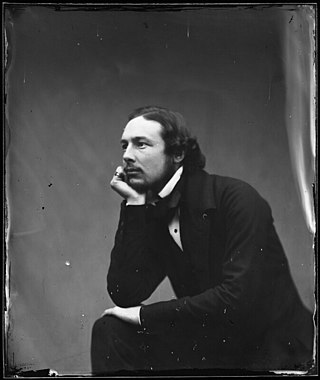
George Price Boyce was a British watercolour painter of landscapes and vernacular architecture in the Pre-Raphaelite style. He was a patron and friend of Dante Gabriel Rossetti.
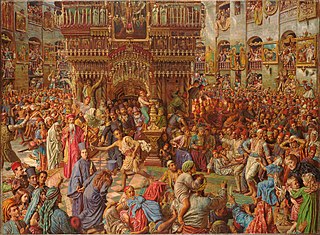
The Miracle of the Holy Fire (1892–1899) is a painting by William Holman Hunt which depicts the Greek Orthodox rite of the Holy Fire in the Church of the Holy Sepulchre Jerusalem. Hunt believed the fire to be a pious fraud which brought Christianity into disrepute. He intended the painting to be a satire in the manner of William Hogarth. Hunt published an elaborate keyplate explaining the identity of the various characters depicted.

A Converted British Family Sheltering a Christian Missionary from the Persecution of the Druids is a painting by William Holman Hunt that was exhibited at the Royal Academy in 1850 and is now in the Ashmolean Museum in Oxford. It was a companion to John Everett Millais's Christ in the House of His Parents. Both artists sought to depict similar episodes from very early Christian history, portraying families helping an injured individual. Both also stressed the primitivism of the scene.
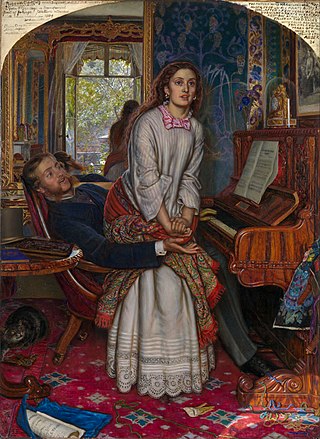
The Awakening Conscience (1853) is an oil-on-canvas painting by the English artist William Holman Hunt, one of the founders of the Pre-Raphaelite Brotherhood, which depicts a woman rising from her position in the lap of a man and gazing transfixed out of the window of a room.
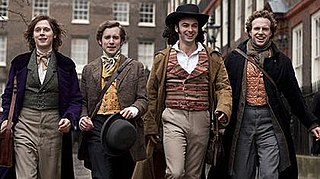
Desperate Romantics is a six-part television drama serial about the Pre-Raphaelite Brotherhood, first broadcast on BBC Two between 21 July and 25 August 2009.

The Girlhood of Mary Virgin is an 1849 oil on canvas painting by the Pre-Raphaelite Brotherhood painter Dante Gabriel Rossetti, measuring 83.2 by 65.4 cm and now in the collection of Tate Britain, to which it was bequeathed in 1937 by Agnes Jekyll. It was his first completed oil painting and is signed "Dante Gabriele Rossetti P.R.B. 1849". He first exhibited it at the 'Free Exhibition' at the Hyde Park Corner Gallery.


















